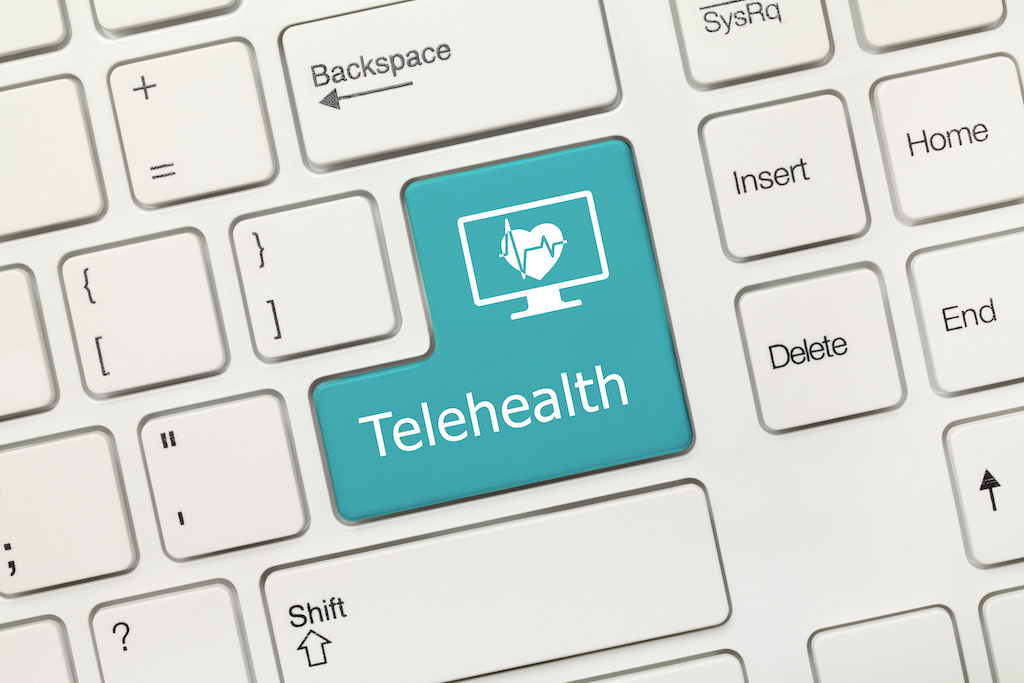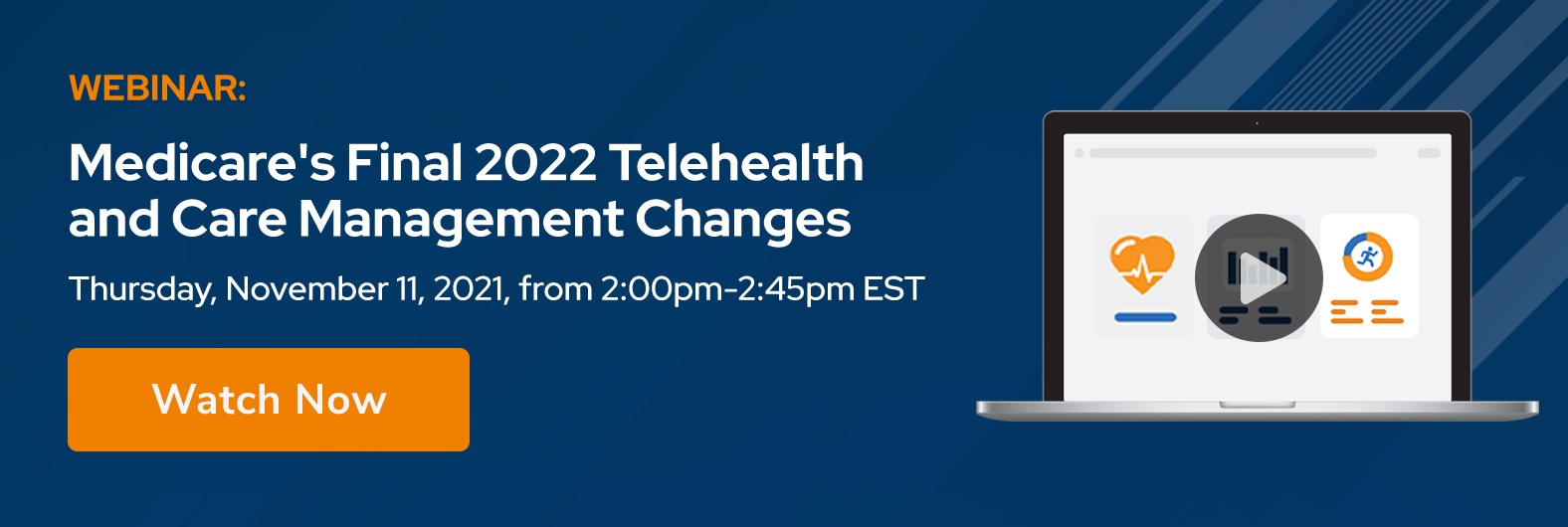It's been about a month since the Centers for Medicare & Medicaid Services (CMS) published its 2022 Medicare Physician Fee Schedule proposed payment rule. Now that we've had some time to digest the document, we wanted to share thoughts on what we feel are some of the most significant proposed changes concerning telehealth and preventive services (e.g., remote patient monitoring, chronic care management). When the final rule is published, we'll be taking a deeper dive into the approved changes for 2022, including hosting a webinar on the topic. Make sure you join our telehealth regulatory update email list so you don't miss when registration for this program opens.
Without further ado, here are six key takeaways about proposed changes to telehealth services for 2022.
1. Future of "direct supervision" via telehealth up in the air
One of the most significant areas we're watching is the rules concerning the future of "direct supervision." In the 2021 Medicare Physician Fee Schedule final rule, CMS adopted an interim policy that revised the definition of direct supervision. Taking into consideration the risks associated with the COVID-19 pandemic, this new definition allowed for the virtual presence of the supervising physician or practitioner using real-time, interactive audio-video communications technology (i.e., telehealth).
In other words, a physician's real-time presence at/live observation of a direct supervision service would no longer be required. Instead, the physician can provide such supervision by being available via interactive audio-video technology. This allows many services that can be furnished by clinical staff, including the Medicare annual wellness visit and other preventive services, to be performed by agents of a provider while those agents are not physically present in the providers office. During the pandemic, we have seen many in clinical call centers contracting with doctors to provide such services to a much larger percentage of the population than was getting those services previously. This interim policy is in effect through the later of the end of the calendar year in which the public health emergency (PHE) ends or Dec. 31, 2021.
In the 2022 proposed rule, CMS stated it is seeking comments of the future of direct supervision via telehealth. More specifically, here are the areas where the agency is requesting feedback:
- Whether this flexibility should potentially be made permanent without limitation after the PHE or if CMS should continue the policy for a short additional time to facilitate a gradual sunset of the policy.
- Whether the current timeframe for continuing the interim policy remains appropriate or if the timeframe should be extended through a later date to allow for the gathering of additional information around the implications of a permanent policy change.
- Whether to permanently allow immediate availability for direct supervision through telehealth for only a subset of services — more specifically, those services that can be provided virtually without raising patient safety risks.
- If the policy were to be made permanent, whether to require a service level modifier to identify when telehealth was used to fulfill direct supervision?
These requests would seem to indicate that Medicare is leaning toward revising the definition of direct supervision and loosening restrictions on how many services can be performed by clinical staff when the billing provider is not physically available following the end of the pandemic. This change, combined with greater telehealth coverage, may allow providers to utilize out-of-office clinical staff — or even contractors — to furnish telehealth services. To what extent may be influenced by the comments it receives about the 2022 proposed rule.
2. Debut of remote therapeutic monitoring (RTM)
The proposed rule made remote therapeutic monitoring one of the top areas practices with current or future plans to implement telehealth and/or remote patient monitoring (RPM) programs to keep an eye on. The proposed rule significantly expanded what was known and understood about RTM but also left many questions unanswered.
This blog on remote therapeutic monitoring summarizes much of what you need to know about RTM for now.
3. Chronic care management (CCM) is shown the love
For practices delivering chronic care management (CCM) services, the proposed rule had a few pieces of positive news, including a proposed substantial reimbursement increase, five new CPT codes, and the inclusion of unusual language in a rule — language that indicates a desire by CMS to ensure better access for patients to CCM.
To learn more about what CMS said about chronic care management and how CCM might look in 2022, read this blog.
4. No new telehealth services
If the proposed rule holds, there will be no new approved Medicare telehealth services for 2022. Despite receiving a number of requests for the permanent addition of such services, CMS stated none met its Category 1 or Category 2 criteria. Criterion for adding services to the Medicare telehealth list under Category 1 is that the requested services are similar to professional consultations, office visits, and office psychiatry services currently on the Medicare telehealth services list. Criterion for adding services under Category 2 is that there is evidence of clinical benefit if provided as telehealth.
The requested services and their respective CPT code(s) are as follows:
| Service Type | CPT Code(s) |
| Urodynamics | 51741 |
| Biofeedback | 90901, 90912, and 90913 |
| Neurological & Psychological Testing Services | 96130–96133 and 96136–96139 |
| Therapy Procedures | 97110, 97112, 97116, 97150, and 97530 |
| Physical Therapy Evaluations | 97161–97164 |
| Therapy Personal Care services | 97535, 97537, and 97542 |
| Therapy Tests and Measurements services | 97750, 97755, and 97763 |
| Personal Care | 98960–98962 |
| Evaluative and Therapeutic Services | 92607–92609 |
5. Extension of Category 3 codes
In the 2021 Medicare Physician Fee Schedule final rule, CMS created a third category (i.e., Category 3) of criteria for adding services to the Medicare telehealth services list on a temporary basis following the end of COVID-19 pandemic. This new category describes services added to the Medicare telehealth services list during the public health emergency (PHE) for which there is likely to be clinical benefit when furnished via telehealth but there was not yet sufficient evidence available to consider the services for permanent addition under Category 1 or Category 2 criteria.
Coverage of Category 3 codes is scheduled to end in the calendar year when the public ends, but in the 2022 proposed rule, CMS is proposing to retain all services added to the Medicare telehealth services list on a Category 3 basis until the end of calendar year 2023. CMS's reasoning is as follows: "This will allow us time to collect more information regarding utilization of these services during the pandemic, and provide stakeholders the opportunity to continue to develop support for the permanent addition of appropriate services to the telehealth list through our regular consideration process, which includes notice-and-comment rulemaking."
In conjunction, CMS is proposing that it would consider other requests to add services to the Medicare telehealth services list on a Category 3 basis using these defined Category 3 criteria.
6. Permanently adopt coding and payment for longer virtual check-in (HCPCS G2252)
In the 2021 final rule, CMS finalized the establishment of Communication Technology-Based Service (CTBS) HCPCS code G2252 and associated payment on an interim basis. This code is defined as follows:
HCPCS G2252 — Brief communication technology-based service, e.g., virtual check-in service, by a physician or other qualified healthcare professional who can report evaluation and management services, provided to an established patient, not originating from a related E/M service provided within the previous 7 days nor leading to an E/M service or procedure within the next 24 hours or soonest available appointment; 11–20 minutes of medical discussion
This code covers extended services delivered via synchronous communication technology, including audio-only solutions.
Prior to the establishment of G2252 on an interim basis, CMS had established HCPCS code G2012. Its definition is as follows:
HCPCS G2012 — Brief communication technology-based service, e.g. virtual check-in, by a physician or other qualified health care professional who can report evaluation and management services, provided to an established patient, not originating from a related e/m service provided within the previous 7 days nor leading to an e/m service or procedure within the next 24 hours or soonest available appointment; 5-10 minutes of medical discussion
In the 2021 final rule, CMS stated its belief that establishing payment for the longer HCPCS G2252 service (11-20 minutes) on an interim basis would support access to care for beneficiaries who may be reluctant to return to in-person visits and permit the agency to consider whether the policy of covering this longer service should be adopted on a permanent basis. In the 2022 proposed rule, CMS is proposing to permanently adopt coding and payment for HCPCS G2252.
Comments on the Proposed 2022 Medicare Physician Fee Schedule
Comments and feedback on the 2022 Medicare Physician Fee Schedule proposed rule must be submitted by 5:00 p.m. ET on Sept. 13, 2021.


